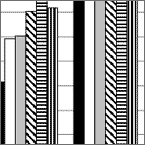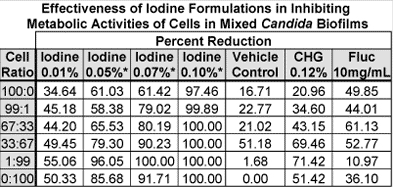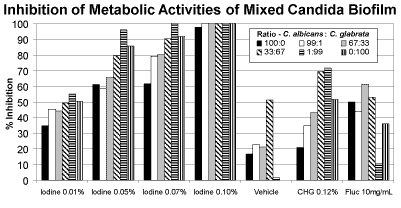
SUPPRESSION OF MIXED CANDIDA BIOFILMS WITH AN IODINE ORAL RINSE
B.M. BHATT¹, C.J. GAUNTT¹, K.P. MCCLOSKEY¹, S.W. REDDING², G. SIEGEL¹
¹Biomedical Development Corporation, San Antonio, TX, USA;
²The University of Texas Health Science Center at San Antonio, San Antonio, TX, USA
Program Number 2316
Abstract
Objective: The purpose of this study was to evaluate the effectiveness of oral candidiasis treatments in inhibiting metabolic activities of yeast cells in mixed biofilms formed by C. albicans and C. glabrata. The products tested included four concentrations of an iodine-based oral rinse (Iocide), chlorhexidine gluconate and fluconazole.
Methods: C. albicans SC5314 and C. glabrata CBS138 were propagated to 1×106 cells/ml. Mixtures of C. albicans to C. glabrata were prepared in the following ratios: 100:0; 99:1; 67:33; 33:67; and 0:100. One-tenth ml of each suspension was added per well in 96 well microtiter plates that were incubated at 37°C for 24hr to allow for biofilm formation. The following treatments were added to groups of 8 wells: oral rinse formulations (0.01%, 0.05%, 0.07%, or 0.1% iodine), placebo oral rinse (no iodine), PBS (cell control), chlorhexidine gluconate oral rinse (0.12%) or fluconazole (10mg/ml oral suspension). Exposure time of each challenge was 60 sec at 22°C. Metabolic activity was determined via XTT reduction assay.
Results: An exposure time of only 1 min was sufficient to reduce metabolic activities of biofilm cells by ≥97% with the formulation tested containing the highest concentration (0.1%) of iodine. The oral rinse formulations containing 0.05%, 0.07%, or 0.1% iodine demonstrated greater reduction of metabolic activity than either chlorhexidine gluconate or fluconazole for all ratios of C. albicans/C. glabrata tested. A doseresponse was observed as increased levels of inhibition of cell metabolic activities corresponded to increasing iodine concentrations. In addition, cells in mixed Candida spp biofilms containing increasing proportions of C. glabrata exhibited increasing susceptibility to the iodine-based formulations.
Conclusions: Iodine-base oral rinse formulations are effective in reducing metabolic activities of cells in mixed C. albicans/C. glabrata biofilms. Iodine-based oral formulations were more effective than both chlorhexidine gluconate and fluconazole in this assay.
Introduction
Over 1.4 million new cases of cancer will be diagnosed in 2007. These are typically treated with radiation therapy or chemotherapy. Radiation therapy or chemotherapy for cancer suppresses the immune system, which causes the patient to become more susceptible to oropharyngeal candidiasis.
Candida albicans has been recognized as the major etiologic microorganism of oropharyngeal candidiasis and/or fungemia in cancer patients for several years, but non-albicans Candida species, including C. glabrata, are increasingly recognized as the etiologic agent involved in these diseases. Treatment of fungal infections in immunosuppressed cancer patients is standard practice, but antifungal therapy results in side effects of variable severity. In addition, isolates of some of non-albicans Candida are quite resistant to some antifungal drugs.
Iocide is a novel iodine-based antimicrobial oral rinse developed for the treatment of biofilm, specifically for the treatment of oral biofilm associated with candidiasis or gingivitis.
Methods
The metabolic activity of C. albicans and C. glabrata cells in biofilms was determined by the XTT (2,3-bis(2-methoxy-4- nitro-5-sulfo-phenyl)- 2H-tetrazolium-5 carboxanilide) -reduction assay. The XTT measures metabolic activity of mitochondrial dehydrogenases in live cells; these enzymes convert a colorless XTT tetrazolium salt into a formazan-colored product. XTT assay absorbance readings have been found to be proportional to the cellular density of the biofilm.
C. albicans SC5314 and C. glabrata CBS138 were propagated in yeast peptone dextrose medium in an orbital shaker at 37°C for 18-20 hr. After washing thrice in PBS, the cells were suspended in RPMI 1640 supplemented with glutamine (2mM) and morpholinepropanesulfonic acid to 1×106 cells/ml.
Mixtures of C. albicans to C. glabrata were prepared in the following ratios: 1)100:0 (C. albicans only control); 2)99:1; 3)67:33; 4)33:67; and 6)0:100 (C. glabrata only control).
One-tenth ml of each suspension was added per well in 96 well microtiter plates that were incubated at 37°C for 24hr to allow for biofilms to form.
Biofilm formation was confirmed by microscopic observation with an inverted microscope at 40X in all cases, except C. glabrata alone, which did not form a biofilm under these conditions, but did grow as a large macrocolony.
After washing each biofilm culture three times with 0.1ml of PBS, 0.1ml of PBS was added to each culture. To start the test, 0.1ml of the iodinebased formulations containing 0.01%, 0.05%, 0.07%, or 0.1% iodine, a preparation without iodine(vehicle only), PBS (cell control), chlorhexidine gluconate oral rinse (0.12%) or fluconazole (10mg/ml oral suspension) was added to groups of 8 samples per treatment. Exposure time of each challenge was 60 sec at 22°C. To block further action of iodine at the end of 60 sec, 25 μl of 0.1N sodium thiosulfate was added to all samples containing iodine formulations.
Cultures exposed to the iodine-less vehicle, PBS, chlorhexidine or fluconazole were diluted with 100 μl of PBS. All fluids were then removed, the biofilm cultures were washed twice with PBS, 0.1ml of XTT reagent was added and the plates were incubated at 37°C for 2hr in the dark and the XTT assay was completed as described by Ramage et al.
Data analysis was performed using a two-way ANOVA with pairwise multiple comparisons.
Results
The data are summarized in the Figure and Table below. Formulations containing 0.05%, 0.07%, and 0.1% iodine were statistically superior (p≤0.01) in one minute treatment when compared to chlorhexidine gluconate, fluconazole and vehicle control in inhibiting metabolic activities of cells in all biofilms tested.
C. glabrata cellular metabolic activities in the large macrocolony were more susceptible to iodine formulations-inhibition than were metabolic activities of cells in C. albicans biofilms. This enhanced susceptibility of C. glabrata cells to the iodine-based formulations was also found in the mixed cell biofilms; as the proportion of C. glabrata to C. albicans cells was increased, the iodine-induced inhibition of metabolic activities increased with increasing proportions of C. glabrata cells. Increased levels of inhibition of cell metabolic activities were found with increasing levels of iodine.

*Significant at p≤0.01 when compared with vehicle, chlorhexidine gluconate, and fluconazole.
Cell ratio = ratio of C. albicans : C. glabrata
CHG = chlorhexidine gluconate
Fluc = fluconazole oral suspension

References
Ramage G, K Vande Walle, BL Wickes, and JL Lopez-Ribot, Standardized method for in vitro antifungal susceptibility testing of Candida albicans biofilms. Antimicrob Agents Chemother, 2001. 45(9): 2475-9.
Acknowledgement
National Institutes of Health / National Institute of Dental and Craniofacial Research. SBIR# 1R43DE17301.
Frio Pharmaceuticals, San Antonio, TX
Presented at the IADR/AADR/CADR 85th General Session and Exhibition (March 21-24, 2007), New Orleans, LA, USA.